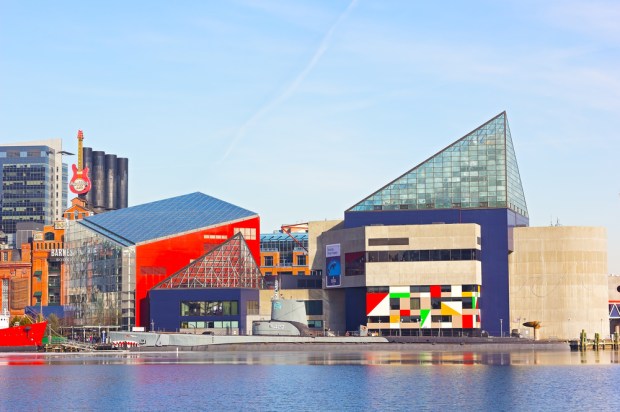Under Armour Wants To ‘Reinvent’ Baltimore, But Not Everyone’s Feeling It

Kevin Plank, Under Amour’s more than ambitious CEO, is seeking more than $1 billion in local, state and federal funding to rebuild a depressed portion of Baltimore’s waterfront known as Fort Covington. The problem, many locals say, is that only Under Armour will benefit from the arrangement.
Plank’s privately-owned development group, Sagamore Development, has purchased about 266 acres of distressed real estate near or around the water in Baltimore and plans to build, from the ground up, over the next 20 or so years, a development known as Port Covington that will include a state of the art new campus for Under Armour, as well as shops and retail centers, 7,500 housing units spread over 50 city blocks, multiple public transportation stops, public parks and even a stable for the city’s police horses.
“What I really want to do is build the biggest brand on the planet,” Plank recently told Bloomberg. “I would love to do that at the same time as anchoring it in a city that could really use a hug. It seems like such a waste for us not to take advantage of the momentum that Under Armour has right now.”
But, despite being met with local resistance to his plan thanks to a vocal contingent that complains that Plank’s plan – which would call for an unprecedented $535 million in tax incremental financing (or TIF) from the city – does not offer enough affordable housing units and is only fit for very high income earners, the real estate investment could prove to be a lucrative proposition for both Plank and the city of Baltimore.
In the early 1990s, Paul Allen, Microsoft’s co-founder, flush with dot-com cash, began investing in downtown real estate for a public park, according to The Wall Street Journal. When the park was rejected by local voters, Allen suddenly controlled a very valuable piece of property in the middle of downtown Seattle.
It was Allen’s first foray into real estate investing, but would lead him to purchase more and more land that he would turn into high-end office space for tech and start-up companies, which would help transform Seattle into the tech-savvy city we know today.
He now owns a LOT of land in Seattle, and several of the major league sports teams in the area.
Facebook moved to its new 430,000 square foot campus in Menlo Park, California 2015, which CEO Mark Zuckerberg described as “the largest open floor plan in the world,” but the company was largely removed from the city itself.
And, then, there are the examples of corporate redevelopment projects gone wrong.
Perhaps the greatest example of this was the city of New London, Conn.’s attempt to seize parcels of land from local residents and businesses in the early 2000s in order to offer it to and placate Pfizer.
The Supreme Court eventually ruled in a 5-4 decision that New London was in the right, but the global pharmaceutical manufacturer – renowned for its Viagra pill – would end up announcing that it was moving its New London operations to a neighboring town in 2009, leaving most of the area promised for urban redevelopment a barren wasteland and just as bad – if not even worse – as before it had moved in.
And that’s what many fear will happen with the Port Covington development, too.
The $535 million TIF that Plank is asking the city to finance as part of his ambitious development plan comes with many caveats.
The investment is funded by selling municipal bonds to private investors, and is then repaid by property taxes generated by the new development. The only problem is that even a consulting firm that Plank’s development company hired to analyze the project estimated that the city would not be paid back by the development until about 2040, and that’s if it hits all its goals.
And Baltimore, like many mid-sized American cities, is pretty much broke right now.
Which is why many local residents are not feeling the proposed development.
What Plank is asking for is terms of local, state and federal money is pretty much unprecedented in urban redevelopment projects and more on terms with sports stadium funding projects.
Those projects, at least, offer a tangible benefit off the bat, by being able to let thousands and thousands of fans root for the local team – and that’s in addition the tourism factor they attract and the possibility to host popular concerts or national sporting events like the Super Bowl.
And Baltimore already has a bunch of sports teams. And none of them need a new home at the moment.
Plank’s request, which the Baltimore City Council could vote on as early as August, would be the third-largest TIF deal for a private company in U.S. history, according to Slate.
Plank envisions Port Covington inspired the same type of kickstart to the Baltimore economy and industry scene as Allen’s investment in the 1990s did for Seattle or the multiple tech firms who have set up shop in Silicon Valley and made that area one of the wealthiest regions on earth and a mecca for entrepreneurs and business visionaries, a sort of “if you build it, they will come” mentality.
The only problem is that Plank wants to build Port Covington using a lot of other peoples money.
If not approved, Plank has not publicly said how Under Armour would react to the news, or where the company would then seek to build its new headquarters.
But Plank has repeatedly made it clear that the company has outgrown its current headquarters in Baltimore.
